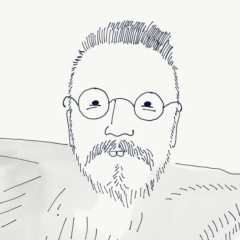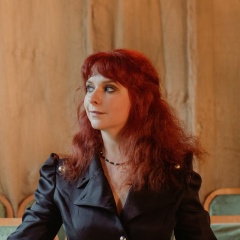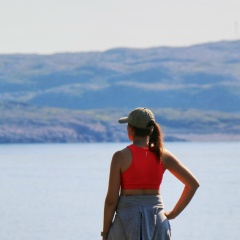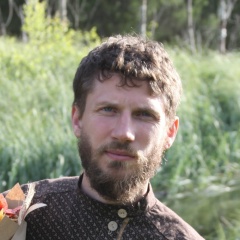04.08.12 День шестой. Погружение в прекрасное: кульминация.
Попрощавшись с гидом, я оказалась один на один с Музеями Ватикана – величайшей сокровищницей, таящей немало уникальных произведений искусства. Слушая скачанный с сайта – и кстати, прекрасный, творческий – аудиогид и читая путеводитель, я двигалась по километровым галереям. Шедевры, которые я сегодня запечатлела на камеру и постаралась запечатлеть в памяти – Лаокон, Аполлон Бельведерский, стоящие в одноименном дворике в Ватикане (вы знаете историю Лаокона? Если нет, могу рассказать…), несколько полотен Тициана, безупречные и возвышенные Станцы Рафаэля, и, наконец – кульминация, синдром Стендаля и очередной эстетический оргазм – Сикстина, расписанная великим Микеланджело Буонаротти. Честно, никогда ничего подобного не видела и не испытывала. Описать это словами невозможно – это надо видеть. Особенно, зная историю создания и те тяжелые испытания, выпавшие на долю автора – невозможно не восхищаться этими Великими произведениями! Изначально около 400 фигур на фреске «Страшный суд» были написаны обнаженными. Микеланджело превозносил красоту человеческого тела и считал, что раз Бог создал человека по образу и подобию своему, в человеке не может быть ничего постыдного. Позже пришедший к власти после Юлия кардинал Карафа открыл чудовищную охоту на произведения, «неугодные» католической церкви. Таким произведением был и Страшный суд – ибо немыслимым в то время было изображение обнаженных людей на стенах здания, где проходили Конклавы. Карафа требовал, чтобы Страшный суд был уничтожен, счищен со стены Сикстины. Одному из учеников Микеланджело удалось отстоять право Суда на существование, пообещав «одеть» фигуры на фреске, завершил он эту работу уже после смерти Микеланджело. И сегодня большинство персонажей Страшного суда предстают перед нами с накинутыми на тела тряпицами. Это была жертва, на которую необходимо было пойти, дабы мы сейчас могли увидеть великое произведение.
На потолке Сикстинской Капеллы изображены библейские сюжеты – двенадцать картин от Сотворения Солнца и Луны до Опьянения Ноя… Как не хотел он браться за эту работу! Вот что пишет о просьбе папы Ирвинг Стоун:
«Мотивы, по которым действовал папа, навязывая Микеланджело этот заказ, стали до ужаса ясными. Дело было не в том, чтобы написать на плафоне великолепные картины, которые дополнили бы уже имеющиеся в капелле фрески, а скорей в том, чтобы замаскировать конструктивные опоры, так неуклюже и грубо соединявшие третий ярус стены с коробовым сводом. Папа приказал Микеланджело написать Апостолов, и эти изображения замышлялись лишь ради того, чтобы они притягивали взор находившихся в капелле людей и тем отвлекали внимание от несуразных архитектурных форм. Как художник Микеланджело делался теперь не просто декоратором, но и маляром, замазывающим чужие огрехи».
На эту немыслимую по масштабности работу у Микеланджело ушло всего 4 года, при том, что он расписывал ее в одиночку. Начинал работу с собственной боттегой, но поняв, что получается не совершенное произведение – распустил помощников и подмастерьев и начал все заново. После четырех лет работы в страшно тяжелых физически условиях, спускаясь с лесов, он думал, что ослеп. Но слава богу, будучи молодым еще мужчиной, он оправился и продолжал творить, даря миру еще столько прекрасного!
Попрощавшись с гидом, я оказалась один на один с Музеями Ватикана – величайшей сокровищницей, таящей немало уникальных произведений искусства. Слушая скачанный с сайта – и кстати, прекрасный, творческий – аудиогид и читая путеводитель, я двигалась по километровым галереям. Шедевры, которые я сегодня запечатлела на камеру и постаралась запечатлеть в памяти – Лаокон, Аполлон Бельведерский, стоящие в одноименном дворике в Ватикане (вы знаете историю Лаокона? Если нет, могу рассказать…), несколько полотен Тициана, безупречные и возвышенные Станцы Рафаэля, и, наконец – кульминация, синдром Стендаля и очередной эстетический оргазм – Сикстина, расписанная великим Микеланджело Буонаротти. Честно, никогда ничего подобного не видела и не испытывала. Описать это словами невозможно – это надо видеть. Особенно, зная историю создания и те тяжелые испытания, выпавшие на долю автора – невозможно не восхищаться этими Великими произведениями! Изначально около 400 фигур на фреске «Страшный суд» были написаны обнаженными. Микеланджело превозносил красоту человеческого тела и считал, что раз Бог создал человека по образу и подобию своему, в человеке не может быть ничего постыдного. Позже пришедший к власти после Юлия кардинал Карафа открыл чудовищную охоту на произведения, «неугодные» католической церкви. Таким произведением был и Страшный суд – ибо немыслимым в то время было изображение обнаженных людей на стенах здания, где проходили Конклавы. Карафа требовал, чтобы Страшный суд был уничтожен, счищен со стены Сикстины. Одному из учеников Микеланджело удалось отстоять право Суда на существование, пообещав «одеть» фигуры на фреске, завершил он эту работу уже после смерти Микеланджело. И сегодня большинство персонажей Страшного суда предстают перед нами с накинутыми на тела тряпицами. Это была жертва, на которую необходимо было пойти, дабы мы сейчас могли увидеть великое произведение.
На потолке Сикстинской Капеллы изображены библейские сюжеты – двенадцать картин от Сотворения Солнца и Луны до Опьянения Ноя… Как не хотел он браться за эту работу! Вот что пишет о просьбе папы Ирвинг Стоун:
«Мотивы, по которым действовал папа, навязывая Микеланджело этот заказ, стали до ужаса ясными. Дело было не в том, чтобы написать на плафоне великолепные картины, которые дополнили бы уже имеющиеся в капелле фрески, а скорей в том, чтобы замаскировать конструктивные опоры, так неуклюже и грубо соединявшие третий ярус стены с коробовым сводом. Папа приказал Микеланджело написать Апостолов, и эти изображения замышлялись лишь ради того, чтобы они притягивали взор находившихся в капелле людей и тем отвлекали внимание от несуразных архитектурных форм. Как художник Микеланджело делался теперь не просто декоратором, но и маляром, замазывающим чужие огрехи».
На эту немыслимую по масштабности работу у Микеланджело ушло всего 4 года, при том, что он расписывал ее в одиночку. Начинал работу с собственной боттегой, но поняв, что получается не совершенное произведение – распустил помощников и подмастерьев и начал все заново. После четырех лет работы в страшно тяжелых физически условиях, спускаясь с лесов, он думал, что ослеп. Но слава богу, будучи молодым еще мужчиной, он оправился и продолжал творить, даря миру еще столько прекрасного!
08/04/12 Day of the sixth. Immersion in the beautiful: the climax.
Saying goodbye to the guide, I was one on one with the Vatican Museums - the greatest treasure trove, concealing many unique works of art. Listening to the audio guide downloaded from the site - and by the way, beautiful, creative - and reading the guidebook, I moved through kilometer galleries. The masterpieces that I captured today on camera and tried to capture in memory - Laokon, Apollon Belvedere, standing in the same yard in the Vatican (do you know the story of Laokon? If not, I can tell ...), several paintings by Titian, flawless and sublime Raphael Station, and finally - the culmination, Stendhal syndrome and the next aesthetic orgasm - Sixteen, painted by the great Michelangelo Buonarotti. Honestly, I have never seen anything like it or experienced it. It is impossible to describe it in words - it must be seen. Especially, knowing the history of creation and the ordeals that befell the author - it is impossible not to admire these great works! Initially, about 400 figures on the Last Judgment mural were painted naked. Michelangelo exalted the beauty of the human body and believed that since God created man in his own image and likeness, there can be nothing shameful in man. Later, Cardinal Carafa, who came to power after Julius, opened a monstrous hunt for works that were "undesirable" to the Catholic Church. The Last Judgment was such a work - for the image of naked people on the walls of the building where the Conclaves were held was unthinkable at the time. Carafa demanded that the Last Judgment be destroyed, stripped from the wall of the Sixteen. One of Michelangelo’s students managed to defend the Court’s right to exist, promising to “dress” figures on the fresco, he completed this work after the death of Michelangelo. And today, most of the characters of the Last Judgment appear before us with rags thrown over their bodies. It was a sacrifice that had to be made, so that we could now see the great work.
On the ceiling of the Sistine Chapel biblical scenes are depicted - twelve paintings from the Creation of the Sun and the Moon to Noah's Drunkenness ... How he did not want to take on this work! Here is what he writes about the request of Pope Irving Stone:
“The motives for which the pope acted, imposing this order to Michelangelo, became terribly clear. The point was not to paint magnificent paintings on the plafond that would complement the frescoes already existing in the chapel, but rather to disguise constructive supports that clumsily and roughly connected the third tier of the wall to the basalt vault. The pope ordered Michelangelo to write the Apostles, and these images were conceived only in order that they attracted the eyes of the people in the chapel and thus distracted attention from the awkward architectural forms. As an artist, Michelangelo was made now not just as a decorator, but also as a painter, smearing other people's flaws. ”
This unimaginable work on the scale of Michelangelo took only 4 years, despite the fact that he painted it alone. He began work with his own bottega, but realizing that it was not a perfect work, he dismissed assistants and apprentices and started all over again. After four years of working in scary physically harsh conditions, descending from the scaffolding, he thought he was blind. But thank God, being a young man, he recovered and continued to create, giving the world so much more beautiful!
Saying goodbye to the guide, I was one on one with the Vatican Museums - the greatest treasure trove, concealing many unique works of art. Listening to the audio guide downloaded from the site - and by the way, beautiful, creative - and reading the guidebook, I moved through kilometer galleries. The masterpieces that I captured today on camera and tried to capture in memory - Laokon, Apollon Belvedere, standing in the same yard in the Vatican (do you know the story of Laokon? If not, I can tell ...), several paintings by Titian, flawless and sublime Raphael Station, and finally - the culmination, Stendhal syndrome and the next aesthetic orgasm - Sixteen, painted by the great Michelangelo Buonarotti. Honestly, I have never seen anything like it or experienced it. It is impossible to describe it in words - it must be seen. Especially, knowing the history of creation and the ordeals that befell the author - it is impossible not to admire these great works! Initially, about 400 figures on the Last Judgment mural were painted naked. Michelangelo exalted the beauty of the human body and believed that since God created man in his own image and likeness, there can be nothing shameful in man. Later, Cardinal Carafa, who came to power after Julius, opened a monstrous hunt for works that were "undesirable" to the Catholic Church. The Last Judgment was such a work - for the image of naked people on the walls of the building where the Conclaves were held was unthinkable at the time. Carafa demanded that the Last Judgment be destroyed, stripped from the wall of the Sixteen. One of Michelangelo’s students managed to defend the Court’s right to exist, promising to “dress” figures on the fresco, he completed this work after the death of Michelangelo. And today, most of the characters of the Last Judgment appear before us with rags thrown over their bodies. It was a sacrifice that had to be made, so that we could now see the great work.
On the ceiling of the Sistine Chapel biblical scenes are depicted - twelve paintings from the Creation of the Sun and the Moon to Noah's Drunkenness ... How he did not want to take on this work! Here is what he writes about the request of Pope Irving Stone:
“The motives for which the pope acted, imposing this order to Michelangelo, became terribly clear. The point was not to paint magnificent paintings on the plafond that would complement the frescoes already existing in the chapel, but rather to disguise constructive supports that clumsily and roughly connected the third tier of the wall to the basalt vault. The pope ordered Michelangelo to write the Apostles, and these images were conceived only in order that they attracted the eyes of the people in the chapel and thus distracted attention from the awkward architectural forms. As an artist, Michelangelo was made now not just as a decorator, but also as a painter, smearing other people's flaws. ”
This unimaginable work on the scale of Michelangelo took only 4 years, despite the fact that he painted it alone. He began work with his own bottega, but realizing that it was not a perfect work, he dismissed assistants and apprentices and started all over again. After four years of working in scary physically harsh conditions, descending from the scaffolding, he thought he was blind. But thank God, being a young man, he recovered and continued to create, giving the world so much more beautiful!






У записи 3 лайков,
0 репостов.
0 репостов.
Эту запись оставил(а) на своей стене Нора Маева
























